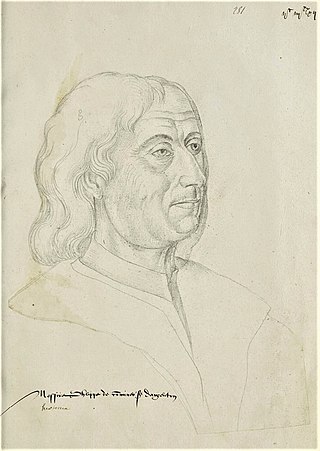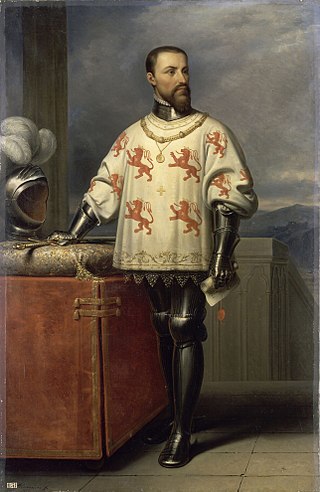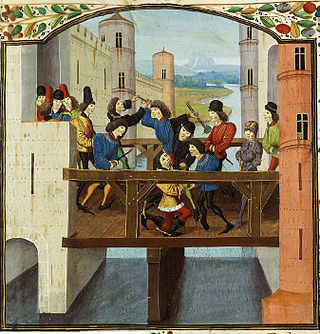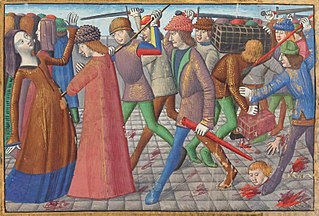
The Capetian house of Valois was a cadet branch of the Capetian dynasty. They succeeded the House of Capet to the French throne, and were the royal house of France from 1328 to 1589. Junior members of the family founded cadet branches in Orléans, Anjou, Burgundy, and Alençon.

Louis XI, called "Louis the Prudent", was King of France from 1461 to 1483. He succeeded his father, Charles VII. Louis entered into open rebellion against his father in a short-lived revolt known as the Praguerie in 1440. The king forgave his rebellious vassals, including Louis, to whom he entrusted the management of the Dauphiné, then a province in southeastern France. Louis's ceaseless intrigues, however, led his father to banish him from court. From the Dauphiné, Louis led his own political establishment and married Charlotte of Savoy, daughter of Louis, Duke of Savoy, against the will of his father. Charles VII sent an army to compel his son to his will, but Louis fled to Burgundy, where he was hosted by Philip the Good, the Duke of Burgundy, Charles' greatest enemy.

Margaret of York, also known by marriage as Margaret of Burgundy, was Duchess of Burgundy as the third wife of Charles the Bold and acted as a protector of the Burgundian State after his death. She was a daughter of Richard, 3rd Duke of York, and Cecily Neville, and the sister of two kings of England, Edward IV and Richard III. She was born at Fotheringhay Castle, Northamptonshire, in the Kingdom of England, and she died at Mechelen in the Low Countries.

Philippe de Commines was a writer and diplomat in the courts of Burgundy and France. He has been called "the first truly modern writer" and "the first critical and philosophical historian since classical times". Neither a chronicler nor a historian in the usual sense of the word, his analyses of the contemporary political scene are what made him virtually unique in his own time.

Charles I, nicknamed the Bold, was Duke of Burgundy from 1467 to 1477.
The Treaty of Troyes was an agreement that King Henry V of England and his heirs would inherit the French throne upon the death of King Charles VI of France. It was formally signed in the French city of Troyes on 21 May 1420 in the aftermath of Henry's successful military campaign in France. It forms a part of the backdrop of the latter phase of the Hundred Years' War finally won by the French at the Battle of Castillon in 1453, and in which various English kings tried to establish their claims to the French throne.
Imbert de Batarnay, Seigneur du Bouchage, French statesman, was born of an old but obscure family in Dauphiné, about the year 1438. In consequence of a chance circumstance he entered into relations with the dauphin Louis at that time (1455) in arms against the king his father; he attached himself to the prince, and followed him on his retreat into Burgundy.

The Congress of Arras was a diplomatic congregation established at Arras in the summer of 1435 during the Hundred Years' War, between representatives of England, France and Burgundy. It was the first negotiation since the Treaty of Troyes and replaced the fifteen-year agreement between Burgundy and England that would have seen the dynasty of Henry V inherit the French crown. Historian Richard Vaughan has called it "Europe's first real peace congress."

The Lancastrian War or sometimes The French War of Independence was the third and final phase of the Hundred Years' War between England and France. It lasted from 1415, when King Henry V of England invaded Normandy, to 1453, when the English lost Bordeaux. It followed a long period of peace from the end of the Caroline War in 1389. The phase is named after the House of Lancaster, the ruling house of the Kingdom of England, to which Henry V belonged.

Louis de Luxembourg, Count of Saint-Pol, of Brienne, de Ligny, and Conversano belonged to the Ligny branch of the House of Luxemburg and was Constable of France.

The War of the Public Weal was a conflict between the king of France and an alliance of feudal nobles, organized in 1465 in defiance of the centralized authority of King Louis XI of France. It was masterminded by Charles the Bold, Count of Charolais, son of the Duke of Burgundy, with the king's brother Charles, Duke of Berry, as a figurehead. The rebels succeeded in attaining concessions from the crown after several months of fighting, though conflict would break out again between the league and the crown in the Mad War of 1485 in a decisive victory for the crown.

Picquigny is a commune in the Somme department in Hauts-de-France in northern France.

Tanneguy III du Châtel was a Breton knight who fought in the Armagnac–Burgundian Civil War and the Hundred Years' War. A member of the Armagnac party, he became a leading adviser of King Charles VII of France, and was one of the murderers of Duke John the Fearless of Burgundy in 1419.

The Armagnac–Burgundian Civil War was a conflict between two cadet branches of the French royal family – the House of Orléans and the House of Burgundy from 1407 to 1435. It began during a lull in the Hundred Years' War against the English and overlapped with the Western Schism of the papacy.
The treaty of Bruges of 1375 was a truce between the Kingdoms of England and France during the Hundred Years' War. It was signed on 27 June 1375 for one year, then extended on 12 March 1376 to 24 June 1377. King Charles V of France retained the territories conquered during his previous military operations. The Duchy of Brittany is returned to France, with the exception of Brest, Auray and Berval which remain the possessions of John IV of Brittany.

The dual monarchy of England and France existed during the latter phase of the Hundred Years' War when Charles VII of France and Henry VI of England disputed the succession to the throne of France. It commenced on 21 October 1422 upon the death of King Charles VI of France, who had signed the Treaty of Troyes which gave the French crown to his son-in-law Henry V of England and Henry's heirs. It excluded King Charles's son, the Dauphin Charles, who by right of primogeniture was the heir to the Kingdom of France. Although the Treaty was ratified by the Estates-General of France, the act was a contravention of the French law of succession which decreed that the French crown could not be alienated. Henry VI, son of Henry V, became king of both England and France and was recognized only by the English and Burgundians until 1435 as King Henry II of France. He was crowned King of France on 16 December 1431.
The Treaty of Amiens, signed on 13 April 1423, was a defensive agreement between Burgundy, Brittany, and England during the Hundred Years' War. The English were represented by John, Duke of Bedford, the English regent of France, the Burgundians by Duke Philip the Good himself, and the Bretons by Arthur de Richemont, on behalf of his brother the Duke of Brittany. By the agreement, all three parties acknowledged Henry VI of England as King of France, and agreed to aid each other against the Valois claimant, Charles VII. It also stipulated the marriage of Bedford and Richemont to Burgundy's sisters, in order to cement the alliance.
The Treaty of London was an agreement between Charles the Bold of Burgundy and Edward IV of England signed on 25 July 1474. In the treaty, Charles agreed to support England militarily during an invasion of France, and to recognise Edward as the King of France.

Gaillard IV de Durfort, Lord of Duras, was a 15th-century Gascon noble of the Durfort family.

The Burgundian State is a concept coined by historians to describe the vast complex of territories that is also referred to as Valois Burgundy.















